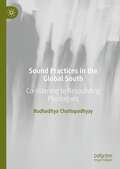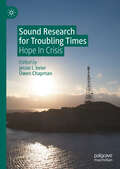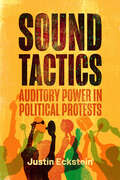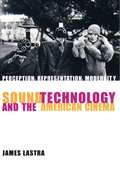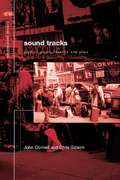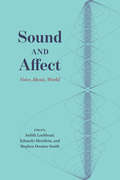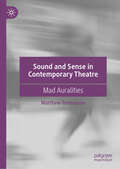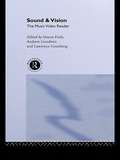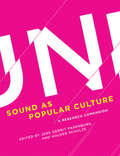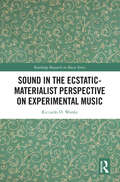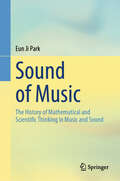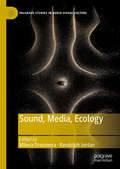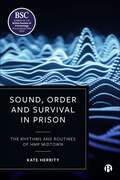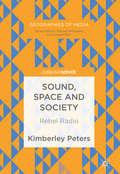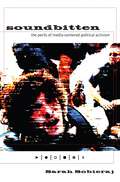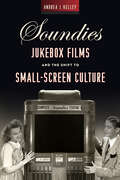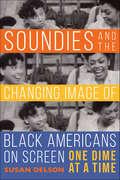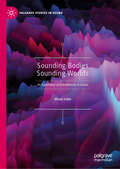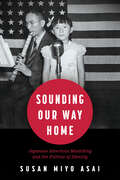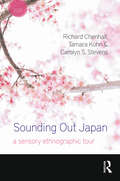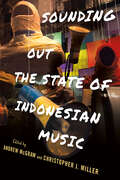- Table View
- List View
Sound Objects
by Rey Chow James A. SteintragerIs a sound an object, an experience, an event, or a relation? What exactly does the emerging discipline of sound studies study? Sound Objects pursues these questions while exploring how history, culture, and mediation entwine with sound’s elusive objectivity. Examining the genealogy and evolution of the concept of the sound object, the commodification of sound, acousmatic listening, nonhuman sounds, and sound and memory, the contributors not only probe conceptual issues that lie in the forefront of contemporary sonic discussions but also underscore auditory experience as fundamental to sound as a critical enterprise. In so doing, they offer exciting considerations of sound within and beyond its role in meaning, communication, and information and an illuminatingly original theoretical overview of the field of sound studies itself. Contributors. Georgina Born, Michael Bull, Michel Chion, Rey Chow, John Dack, Veit Erlmann, Brian Kane, Jairo Moreno, John Mowitt, Pooja Rangan, Gavin Steingo, James A. Steintrager, Jonathan Sterne, David Toop
Sound Poetics
by Seán StreetThis book examines sonic signals as something both heard internally and externally, through imagination, memory and direct response. In doing so it explores how the mind 'makes' sound through experience, as it interprets codes on the written page, and creates an internal leitmotif that then interacts with new sounds made through an aural partnership with the external world, chosen and involuntary exposure to music and sound messages, both friendly and antagonistic to the identity of the self. It creates an argument for sound as an underlying force that links us to the world we inhabit, an essential part of being in the same primal sense as the calls of birds and other inhabitants of a shared earth. Street argues that sound as a poetic force is part of who we are, linked to our visualisation and sense of the world, as idea and presence within us. This incredibly interdisciplinary book will be of great interest to scholars of radio, sound, media and literature as well as philosophy and psychology.
Sound Practices in the Global South: Co-listening to Resounding Plurilogues
by Budhaditya ChattopadhyayThis book develops a comprehensive understanding of the unique sound worlds of key regions in the Global South, through an auto-ethnographic method of self-reflective conversations with prominent sound practitioners from South Asia, Africa, the Middle East and Latin America. The conversations navigate various trajectories of sound practices, illuminating intricate sonic processes of listening, thinking through sounds, ideating, exposing, and performing with sound. This collection of conversations constitutes the main body of the book, including critical and scholarly commentaries on aural cultures, sound theory and production. The book builds a ground-up approach to nurturing knowledge about aural cultures and sonic aesthetics, moving beyond the Eurocentric focus of contemporary sound studies. Instead of understanding sound practices through consumption and entertainment, they are explored as complex cultural and aesthetic systems, working directly with the practitioners themselves, who largely contribute to the development of the sonic methodologies. Refocusing on the working methods of practitioners, the book reveals a tension between the West’s predominant colonial-consumerist cultures, and the collective desires of practitioners to resist colonial models of listening by expressing themselves in terms of their arts and craft, and their critical faculties.Conversations with: Clarence Barlow, Sandeep Bhagwati, Rajesh K. Mehta, Sharif Sehnaoui, Ximena Alarcón Díaz, Hardi Kurda, Mario de Vega, Luka Mukhavele, Khyam Allami, Cedrik Fermont, Khaled Kaddal, David Velez, Juan Duarte, Youmna Saba, Abdellah M. Hassak, Mariana Marcassa, Amanda Gutiérrez, Syma Tariq, Alma Laprida, Siamak Anvari, Mohamad Safa, Debashis Sinha, Zouheir Atbane, Constanza Bizraelli, Jatin Vidyarthi, Joseph Kamaru, Surabhi Saraf, Isuru Kumarasinghe, Hemant Sreekumar.
Sound Research for Troubling Times: Hope In Crisis
by Jessie L. Beier Owen ChapmanThis edited collection takes the prompt “hope in crisis” as a starting point for investigating sound research as it is situated in these troubling times. The book brings together thinkers from numerous scholarly domains (i.e. communication studies, art education, creative art therapy, psychology and philosophy) to explore the question of hope as it relates to sonic research-creation practices in/and times of crisis. Some of the prompts and provocations explored by the authors within the collection include, but are not limited to: explorations of sonic research-creation practices as they are situated within contemporary convergence of crises; theoretical investigations of the concept of hope as it relates to sonic temporalities, ontologies, and epistemologies; articulations of experimental sonic pedagogies; examinations of hope as it plays out in institutional settings and/or sound and music scenes (i.e. music education, artistic communities, activist communities); investigations of experimental listening practices as they relate to contemporary crises; explorations of post-human, non-human, and inhuman sonic resonances in research-creation practices; and experimental practices that deploy sound and sonic approaches for emergent, collective research both within, but also outside of, academic institutions. Positioned as a material that holds the potential to frustrate common approaches to research, whether through its refusal of occularcentric perspectives, its leaky data protocols or its distortion of future horizons, sound is explored here as that which might counter the default refrains that have pushed hope itself into crisis. Importantly, while sound research is explored in this book in relation to hope, it is not offered up as a better way forward, nor is it presented as a solution. Sound research is instead posed as a question, with each author responding in their own way through experiments with the potentials, but also limits, of and for sonic practices. Central to the project, then, is the question of how to collectively and creatively respond to the increasingly difficult— even untenable—circumstances that have come to limit future possibilities, both within fields of research but also beyond, without falling back on the unquestioned assumption that hope alone will actualize a desired otherworld. The sound research gathered here experiments with such possibilities in order to grapple with how present conditions, including conditions for research, are always contingent—always already in trouble—and thus also subject to change both conceptually and materially.
Sound Tactics: Auditory Power in Political Protests (RSA Series in Transdisciplinary Rhetoric)
by Justin EcksteinFrom call and response chants to the noise of pots and pans, protests are often defined by their sounds. In this book, Justin Eckstein argues that this is not merely the result of catchy slogans; it is due to sound’s ability to hold those in power accountable. Sound Tactics highlights how, in a world grappling with the uncertainty of emergent digital practices, social movements utilize the rhetorical power of sound.Eckstein uses the waveform as a metaphor for the persuasive potential of sound. Examining the case studies of the March for Our Lives protest, Howard University’s HUResist movement, and the Casseroles protest in Montreal, Eckstein demonstrates how changes to the immediacy, intensity, and immersiveness of sound can affect the power of an argument. The collective use of sound in these case studies conveys the unity of the protestors in their demand for change and underlines the strength of their argument to those in power.More than just the written word spoken aloud, sound has unique layers of added meaning—it can convey length of time, demand attention, and signal disapproval. Eckstein’s study unpacks those layers for scholars and students, as well as activists interested in deploying sound for change.
Sound Technology and the American Cinema: Perception, Representation, Modernity (Film and Culture Series)
by James LastraRepresentational technologies including photography, phonography, and the cinema have helped define modernity itself. Since the nineteenth century, these technologies have challenged our trust of sensory perception, given the ephemeral unprecedented parity with the eternal, and created profound temporal and spatial displacements. But current approaches to representational and cultural history often neglect to examine these technologies. James Lastra seeks to remedy this neglect.Lastra argues that we are nowhere better able to track the relations between capital, science, and cultural practice than in photography, phonography, and the cinema. In particular, he maps the development of sound recording from its emergence to its confrontation with and integration into the Hollywood film.Reaching back into the late eighteenth century, to natural philosophy, stenography, automata, and human physiology, Lastra follows the shifting relationships between our senses, technology, and representation.
Sound Tracks: Popular Music Identity and Place (Critical Geographies)
by Chris Gibson John ConnellSound Tracks is the first comprehensive book on the new geography of popular music, examining the complex links between places, music and cultural identities. It provides an interdisciplinary perspective on local, national and global scenes, from the 'Mersey' and 'Icelandic' sounds to 'world music', and explores the diverse meanings of music in a range of regional contexts.In a world of intensified globalisation, links between space, music and identity are increasingly tenuous, yet places give credibility to music, not least in the 'country', and music is commonly linked to place, as a stake to originality, a claim to tradition and as a marketing device. This book develops new perspectives on these relationships and how they are situated within cultural and geographical thought.
Sound and Affect: Voice, Music, World
by Eduardo Mendieta Judith Lochhead Stephen Decatur SmithThere is no place on earth that does not echo with the near or distant sounds of human activity. More than half of humanity lives in cities, meaning the daily soundtrack of our lives is filled with sound—whether it be sonorous, harmonious, melodic, syncopated, discordant, cacophonous, or even screeching. This new anthology aims to explore how humans are placed in certain affective attitudes and dispositions by the music, sounds, and noises that envelop us. ?Sound and Affect maps a new territory for inquiry at the intersection of music, philosophy, affect theory, and sound studies. The essays in this volume consider objects and experiences marked by the correlation of sound and affect, in music and beyond: the voice, as it speaks, stutters, cries, or sings; music, whether vocal, instrumental, or machine-made; and our sonic environments, whether natural or artificial, and how they provoke responses in us. Far from being stable, correlations of sound and affect are influenced and even determined by factors as diverse as race, class, gender, and social and political experience. Examining these factors is key to the project, which gathers contributions from a cross-disciplinary roster of scholars, including both established and new voices. This agenda-setting collection will prove indispensable to anyone interested in innovative approaches to the study of sound and its many intersections with affect and the emotions.
Sound and Sense in Contemporary Theatre: Mad Auralities
by Matthew TomkinsonThis book is among the first to consider the subject of mad auralities in theatre and performance, asking: what does it mean to hear and listen madly? Drawing widely upon mad studies, critical disability studies, theatre studies, sound studies, queer studies, and critical race theory, it seeks to explore the theatrical relationship between sound and mental health differences by examining a range of case studies in which audience members are immersed in auditory simulations of madness. Ultimately, however, this critical study investigates the shortcomings of simulation as a representational practice, in keeping with the critical tradition of disability studies and mad studies.
Sound and Vision: The Music Video Reader
by Lawrence Grossberg Simon Frith Andrew GoodwinSound and Vision is the first significant collection of new and classic texts on video and brings together some of the leading international cultural and music critics writing today. Addressing one of the most controversial forms of popular culture in the contemporary world, Sound and Vision confronts easy interpretations of music video - as promotional vehicles, filmic images and postmodern culture - to offer a new and bold understanding of its place in pop music, television and the media industries. The book acknowledges the history of the commercial status of pop music as a whole, as well as its complex relations with other media. Sound and Vision will be an essential text for students of popular music and popular culture.
Sound as Popular Culture: A Research Companion
by Holger Schulze Jens Gerrit PapenburgScholars consider sound and its concepts, taking as their premise the idea that popular culture can be analyzed in an innovative way through sound.The wide-ranging texts in this book take as their premise the idea that sound is a subject through which popular culture can be analyzed in an innovative way. From an infant's gurgles over a baby monitor to the roar of the crowd in a stadium to the sub-bass frequencies produced by sound systems in the disco era, sound—not necessarily aestheticized as music—is inextricably part of the many domains of popular culture. Expanding the view taken by many scholars of cultural studies, the contributors consider cultural practices concerning sound not merely as semiotic or signifying processes but as material, physical, perceptual, and sensory processes that integrate a multitude of cultural traditions and forms of knowledge.The chapters discuss conceptual issues as well as terminologies and research methods; analyze historical and contemporary case studies of listening in various sound cultures; and consider the ways contemporary practices of sound generation are applied in the diverse fields in which sounds are produced, mastered, distorted, processed, or enhanced. The chapters are not only about sound; they offer a study through sound—echoes from the past, resonances of the present, and the contradictions and discontinuities that suggest the future.ContributorsKarin Bijsterveld, Susanne Binas-Preisendörfer, Carolyn Birdsall, Jochen Bonz, Michael Bull, Thomas Burkhalter, Mark J. Butler, Diedrich Diederichsen, Veit Erlmann, Franco Fabbri, Golo Föllmer, Marta García Quiñones, Mark Grimshaw, Rolf Großmann, Maria Hanáček, Thomas Hecken, Anahid Kassabian, Carla J. Maier, Andrea Mihm, Bodo Mrozek, Carlo Nardi, Jens Gerrit Papenburg, Thomas Schopp, Holger Schulze, Toby Seay, Jacob Smith, Paul Théberge, Peter Wicke, Simon Zagorski-Thomas
Sound in the Ecstatic-Materialist Perspective on Experimental Music (Routledge Research in Music)
by Riccardo D. WankeWhat does a one hour contemporary orchestral piece by Georg Friedrich Haas have in common with a series of glitch-noise electronic tracks by Pan Sonic? This book proposes that, despite their differences, they share a particular understanding of sound that is found across several quite distinct genres of contemporary art music: the ecstatic-materialist perspective. Sound in the ecstatic-materialist perspective is considered as a material mass or element, unfolding in time, encountered by a listener, for whom the experience of that sound exceeds the purely sonic without becoming entirely divorced from its materiality. It is "material" by virtue of the focus on the texture, consistency, and density of sound; it is "ecstatic" in the etymological sense, that is to say that the experience of this sound involves an instability; an inclination to depart from material appearance, an ephemeral and transitory impulse in the very perception of sound to something beyond – but still related to – it. By examining musical pieces from spectralism to electroacoustic domains, from minimalism to glitch electronica and dubstep, this book identifies the key intrinsic characteristics of this musical perspective. To fully account for this perspective on sonic experience, listener feedback and interviews with composers and performers are also incorporated. Sound in the ecstatic-materialist perspective is the common territory where composers, sound artists, performers, and listeners converge.
Sound of Music: The History of Mathematical and Scientific Thinking in Music and Sound
by Eun Ji ParkThis book explains that the essence of music lies in intangible mental realms. While vibrations generate sound, and sound forms music, music represents something far beyond mere phenomena—a higher form of expression. This book describes how vibrations are transmitted to the human ear, stirring emotions and ultimately moving the soul. This complex process defies full comprehension. Nevertheless, humanity has long sought to uncover the secrets of music and sound, striving since ancient times to objectively interpret them. This book begins by exploring this endeavor as both a way of observing phenomena and attempting to understand the world, posing the following questions: How have we interpreted music and sound throughout history? What origins have we ascribed to music and sound? How have we analyzed sound phenomena with different technologies up to the present day? Throughout history, scholars have observed and analyzed music and sound from different perspectives, initially seeking to understand sound through numerical frameworks and later employing scientific experimentation to analyze it more precisely. The observations and theories discovered along the way have established a rich body of knowledge, enabling us to accurately understand sound phenomena through mathematics and science. This book emphasizes that the artistic domain of music and the scientifically analyzed realm of sound are bound in an inseparable, symbiotic relationship. It argues that those who truly wish to understand music must acquire knowledge of sound. The quality of sound (La qualité du Son), as this book demonstrates, plays a crucial role in shaping the emotional impact of music, with listeners&’ experiences varying significantly based on sound quality. In some respects, sound itself may play an even more important role than any other aspect in forming music. Ultimately, this book provides foundational knowledge of music and sound from diverse perspectives while explaining their connections within the historical contexts of music and science.
Sound, Media, Ecology (Palgrave Studies in Audio-Visual Culture)
by Milena Droumeva Randolph JordanThis volume reads the global urban environment through mediated sonic practices to put a contemporary spin on acoustic ecology’s investigations at the intersection of space, cultures, technology, and the senses. Acoustic ecology is an interdisciplinary framework from the 1970s for documenting, analyzing, and transforming sonic environments: an early model of the cross-boundary thinking and multi-modal practices now common across the digital humanities. With the recent emergence of sound studies and the expansion of “ecological” thinking, there is an increased urgency to re-discover and contemporize the acoustic ecology tradition. This book serves as a comprehensive investigation into the ways in which current scholars working with sound are re-inventing acoustic ecology across diverse fields, drawing on acoustic ecology’s focus on sensory experience, place, and applied research, as well as attendance to mediatized practices in sounded space. From sounding out the Anthropocene, to rethinking our auditory media landscapes, to exploring citizenship and community, this volume brings the original acoustic ecology problem set into the contemporary landscape of sound studies.
Sound, Order and Survival in Prison: The Rhythms and Routines of HMP Midtown
by Kate HerrityThe soundscape of prison life is that of constant clangs, bangs and jangles. What is the significance of this cacophonous din to those who live and work with it? This book tells the story of a year spent with a UK prison community, bringing its social world vividly to life for the first time through aural ethnography. Kate Herrity’s sensory criminology challenges current thinking on how power is experienced by the imprisoned and the lasting effects of incarceration for all who spend time in these environments.
Sound, Space and Sociality in Modern Japan (Routledge Contemporary Japan Series)
by Joseph D. Hankins Carolyn S. StevensThis book argues that sound – as it is created, transmitted, and perceived – plays a key role in the constitution of space and community in contemporary Japan. The book examines how sonic practices reflect politics, aesthetics, and ethics, with transformative effects on human relations. From right-wing sound trucks to left-wing protests, from early 20th century jazz cafes to contemporary avant-garde art forms, from the sounds of U.S. military presence to exuberant performances organized in opposition, the book, rich in ethnographic detail, contributes to sensory anthropology and the anthropology of contemporary Japan.
Sound, Space and Society
by Kimberley PetersIn 1964, rebel radio stations took to the seas in converted ships to offer listening choice to a young, resistant audience, against a backdrop of restrictive broadcasting policies. This book draws on this exceptional moment in social history, and the decades that followed, teasing out the relations between sound, society and space that were central to 'pirate' broadcasting activities. With a turn towards mediated life in geography, studies of radio have been largely absent. However, radio remains the most pervasive mass communications medium. This book breaks new ground, discussing in depth the relationship between radio, space and society; considering how space matters in the production, consumption and regulation of audio transmission, through the geophysical spaces of sea, land and air. It is relevant for readers interested in geographies of media, sensory spatial experience, everyday geopolitics and the turn towards elemental and more-than-human geographies.
Soundbitten: The Perils of Media-Centered Political Activism
by Sarah SobierajThere is an elaborate and often invisible carnival that emerges alongside presidential campaigns as innumerable activist groups attempt to press their issues into mainstream political discourse. Sarah Sobieraj’s fascinating ethnographic portrait of fifty diverse organizations over the course of two campaign cycles reveals that while most activist groups equate political success with media success and channel their energies accordingly, their efforts fail to generate news coverage and come with deleterious consequences. Sobieraj shows that activists’ impact on public political debates is minimal, and carefully unravels the ways in which their all-consuming media work and unrelenting public relations approach undermine their ability to communicate with pedestrians, comes at the expense of other political activities, and perhaps most perniciously, damages the groups themselves.Weaving together fieldwork, news analysis, and in-depth interviews with activists and journalists, Soundbitten illuminates the relationship between news and activist organizations. This captivating portrait of activism in the United States lays bare the challenges faced by outsiders struggling to be heard in a mass media dominated public sphere that proves exclusionary and shows that media-centrism is not only ineffective, but also damaging to group life. Soundbitten reveals why media-centered activism so often fails, what activist groups lose in the process, and why we should all be concerned.
Soundies Jukebox Films and the Shift to Small-Screen Culture (Techniques of the Moving Image)
by Andrea J. KelleySoundies Jukebox Films and the Shift to Small-Screen Culture is the first and only book to position what are called “Soundies” within the broader cultural and technological milieu of the 1940s. From 1940 to 1946, these musical films circulated in everyday venues, including bars, bowling alleys, train stations, hospitals, and even military bases. Viewers would pay a dime to watch them playing on the small screens of the Panoram jukebox. This book expands U.S. film history beyond both Hollywood and institutional film practices. Examining the dynamics between Soundies’ short musical films, the Panoram’s film-jukebox technology, their screening spaces and their popular discourse, Andrea J. Kelley provides an integrative approach to historic media exhibition. She situates the material conditions of Soundies’ screening sites alongside formal considerations of the films and their unique politics of representation to illuminate a formative moment in the history of the small screen.
Soundies and the Changing Image of Black Americans on Screen: One Dime at a Time
by Susan DelsonIn the 1940s, folks at bars and restaurants would gather around a Panoram movie machine to watch three-minute films called Soundies, precursors to today's music videos. This history was all but forgotten until the digital era brought Soundies to phones and computer screens—including a YouTube clip starring a 102-year-old Harlem dancer watching her younger self perform in Soundies. In Soundies and the Changing Image of Black Americans on Screen: One Dime at a Time, Susan Delson takes a deeper look at these fascinating films by focusing on the role of Black performers in this little-known genre. She highlights the women performers, like Dorothy Dandridge, who helped shape Soundies, while offering an intimate look at icons of the age, such as Duke Ellington and Nat King Cole. Using previously unknown archival materials—including letters, corporate memos, and courtroom testimony—to trace the precarious path of Soundies, Delson presents an incisive pop-culture snapshot of race relations during and just after World War II.Perfect for readers interested in film, American history, the World War II era, and Black entertainment history, Soundies and the Changing Image of Black Americans on Screen and its companion video website (susandelson.com) bring the important contributions of these Black artists into the spotlight once again.
Sounding Bodies Sounding Worlds: An Exploration of Embodiments in Sound (Palgrave Studies in Sound)
by Mickey ValleeWhat makes a body of sound appear as an aesthetic object as well as a method for knowledge? In Sounding Bodies Sounding Worlds, Mickey Vallee argues that we must impose our sonic imagination onto the non-sonic, and embrace how we sound to ourselves, sound with our animal companions, and sound in very earth itself. From the invention of the laryngoscope to the role of the spectrogram, from the call of the bird to the tumble of a rockslide, from the deep listening of environmental immersion to the computational listening of bioacoustics research, Vallee offers a wide range of cases to convincingly argue that all life shares in a continuous, embodied and ethical vibration.
Sounding Bodies: Acoustical Science and Musical Erotics in Victorian Literature (SUNY series, Studies in the Long Nineteenth Century)
by Shannon DrauckerCan the concert hall be as erotic as the bedroom? Many Victorian writers believed so. In the mid-nineteenth century, acoustical scientists such as Hermann von Helmholtz and John Tyndall described music as a set of physical vibrations that tickled the ear, excited the nerves, and precipitated muscular convulsions. In turn, writers—from canonical figures such as George Eliot and Thomas Hardy, to New Women novelists like Sarah Grand and Bertha Thomas, to anonymous authors of underground pornography—depicted bodily sensations and experiences in unusually explicit ways. These writers used scenes of music listening and performance to intervene in urgent conversations about gender and sexuality and explore issues of agency, pleasure, violence, desire, and kinship. Sounding Bodies shows how both classical music and Victorian literature, while often considered bastions of conservatism and repression, represented powerful sites for feminist and queer politics.
Sounding Our Way Home: Japanese American Musicking and the Politics of Identity
by Susan Miyo AsaiA product of twenty-five years of archival and primary research, Sounding Our Way Home: Japanese American Musicking and the Politics of Identity narrates the efforts of three generations of Japanese Americans to reach “home” through musicking. Using ethnomusicology as a lens, Susan Miyo Asai examines the musical choices of a population that, historically, is considered outside the racial and ethnic boundaries of American citizenship. Emphasizing the notion of national identity and belonging, the volume provokes a discussion about the challenges of nation-building in a democratic society.Asai addresses the politics of music, interrogating the ways musicking functions as a performance of social, cultural, and political identification for Japanese Americans in the United States. Musicking is an inherently political act at the intersection of music, identity, and politics, particularly if it involves expressing one’s ethnicity and/or race. Asai further investigates how Japanese American ethnic identification and cultural practices relate to national belonging. Musicking cultivates a narrative of a shared history and aesthetic between performers and listeners. The discourse situates not only Japanese Americans, but all Asians into the Black/white binary of race relations in the United States.Sounding Our Way Home contributes to the ongoing struggle for acceptance and equal representation for people of color in the US. A history of Japanese American musicking across three generations, the book unveils the social and political discrimination that nonwhite immigrants and their offspring continue to face when it comes to finding acceptance in US society and culture.
Sounding Out Japan: A Sensory Ethnographic Tour (Sensory Studies)
by Tamara Kohn Richard Chenhall Carolyn S. StevensThis book takes the reader on a sensory ethnographic tour in Japan and describes the many ways sounds seep into everyday experiences. So many ethnographies describe local worlds with a deep attention to what is seen and what people say, but with a limited understanding of the broader sonic environments that enrich and inform everyday life. Through a focus on sounds, both real and imagined, the volume employs a critical ear to engage with a range of sonically enriched encounters, including crosswalk melodies in streetscapes, announcements and jingles at train stations, water features in gardens, dosimeters in nuclear affected zones, sounds of training in music and martial arts halls and celebrations under blossoming cherry trees. The authors use various analytic frames to understand the communicative and symbolic aspects of sounds and to sense the layers of historical meaning, embodied action and affect associated with sonic environments.
Sounding Out the State of Indonesian Music (Cornell Modern Indonesia Project)
by Andrew McGraw Christopher J. MillerSounding Out the State of Indonesian Music showcases the breadth and complexity of the music of Indonesia. By bringing together chapters on the merging of Batak musical preferences and popular music aesthetics; the vernacular cosmopolitanism of a Balinese rock band; the burgeoning underground noise scene; the growing interest in kroncong in the United States; and what is included and excluded on Indonesian media, editors Andrew McGraw and Christopher J. Miller expand the scope of Indonesian music studies. Essays analyzing the perception of decline among gamelan musicians in Central Java; changes in performing arts patronage in Bali; how gamelan communities form between Bali and North America; and reflecting on the "refusion" of American mathcore and Balinese gamelan offer new perspectives on more familiar topics.Sounding Out the State of Indonesian Music calls for a new paradigm in popular music studies, grapples with the imperative to decolonialize, and recognizes the field's grounding in diverse forms of practice.


